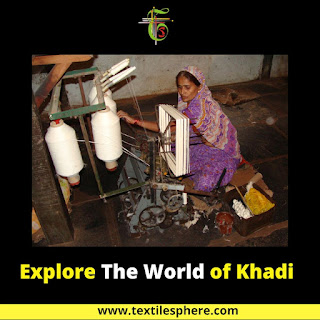Khadi is a handloom woven fabric produced in India, and traditionally used to make clothes. It is made of pure cotton and is dyed with natural dyes. Khadi is traditionally made by handspinning, dyeing and weaving, using handlooms which are locally called "khadi" or "khaddar" in Hindi.
Khadi has been an integral
part of Indian culture for thousands of years. The first use of the term
"Khadi" was during the reign of the Mughal Emperor Akbar (1556–1605).
He encouraged his subjects to wear cotton clothing instead of imported silks.
The word "khadi" means hand-spun fabric, which became synonymous with
Indian textiles.
The Indian khadi industry
has grown rapidly over the past few decades because it provides employment to
millions of women in rural communities across India. Khadi fabric is a traditional
handloom fabric produced in India. It is the traditional and traditional fabric
of India, which has a long history. Khadi is a part of Indian culture and
heritage. Khadi fabric is woven on handlooms or handlooms, which work by hand
in order to produce khadi fabrics. The word "khadi" means
"homespun," which refers to the process of weaving by hand on natural
fibers such as cotton, silk or wool.
India is a leader in the
making of khadi fabric. Khadi is a unique, handloomed textile that is woven from
cotton and entirely handmade. The first use of khadi for manufacturing in India
was in the late 18th century.
Khadi has been made by hand
for hundreds of years, and has come to symbolize India's rich heritage,
particularly its spiritual traditions. Every year millions of Indians make
their own clothes, including cloths, saris and salwar kameez (traditional
dresses), using traditional methods they learned from their mothers or
grandmothers.
Khadi fabric has been made
in India since ancient times. During British rule, regulations were issued to
control production, but it was not until 1947 that efforts were made to revive
textile production. Since then, production has expanded rapidly and today there
are more than 100 mills producing over 10 million pieces daily.
In 2010 Khadi & Village
Industries Commission (KVIC) launched its 'Make In India' campaign to encourage
local manufacturing and consumption of Indian products; this has resulted in
increased demand for Khadi products in India, particularly among rural
communities. The Khadi and Village Industries Commission (KVIC) is the nodal
agency of Government of India, under the Ministry of Micro, Small and Medium
Enterprise (MSME) which promotes sustainable use of handspun cotton and linen
yarns, threads and fabrics.It is also responsible for setting up cottage
industries under the Khadi Village Industries Promotion Scheme.
The process of manufacturing
khadi involved many steps such as carding the raw cotton into threads, washing
and drying it before weaving it into cloth. This meant that no two pieces of
khadi could be exactly alike because each piece was unique due to its handmade
nature.
Khadi cotton was
traditionally used for making bedsheets and other garments, including clothing
for men and women. Today, it is also used for many other purposes such as
wrapping food for sale in shops and restaurants, making bags and purses, using
as packaging material for products sold at markets and fairs, etc., such as
those made from bamboo or jute yarns
Khadi marketing is a local
craft marketing, which is based on the art of handloom weaving. The term Khadi
was coined by Mahatma Gandhi in 1928 and it has been given a status of its own
since then in the Indian government policy. Khadi is not only a product, but
also a movement that helped hundreds of thousands of women to take part in the
freedom struggle against British rule. Khadi marketing involves promoting khadi
products through various activities such as exhibitions, fairs, seminars,
promotions and workshops. It also involves giving training programs on how to
make this textile product so that people can sell it for themselves or for
others.
The Government of India has
established Khadi Gram Udyog Vikas Nigam Limited (KGUVNL) to promote khadi
products in India and abroad. The KGUVNL was promoted as a public sector
undertaking under the Department of Textiles, Government of India. The main
objective behind its establishment was to produce khadi yarns and fabrics on
commercial basis for use by manufacturers and consumers alike.
Khadi Marketing Strategy:
Khadi Marketing Strategy may
take the form of a single promotional activity or a combination of promotional
activities. The main objective behind khadi marketing strategy should be to
make khadi products more visible to the consumer who is primarily interested in
buying those products having good quality and reasonable prices.
The following are some
objectives that can be pursued while developing a khadi marketing strategy:
- To create awareness about khadi products among potential customers (both existing as well as potential) at different levels.
- To create demand for khadi products through advertising campaigns which will help increase their market share in terms of sales volume as well as market share in terms of profit margins.
- To achieve these objectives through various types of promotions like product launches, displays, exhibitions, etc., which will help in increasing awareness about khadi products among potential customers (both existing as well as potential) at different levels








0 Comments